As a common sheet metal processing equipment, a laser cutting machine plays a vital role.
Efficient and high-precision cutting is deeply rooted in people's minds.
However, after prolonged use, the equipment's performance may decrease and even the cutting board may show large cuts, which may affect the quality of the cut.
This issue needs to be resolved immediately. Let's take a closer look below.
The cutting performance of an optical fiber laser cutting machine decreases due to wear and tear on the machine after prolonged use, as well as due to insufficient maintenance during machine operation.
What is the cutting size of laser cutting ?
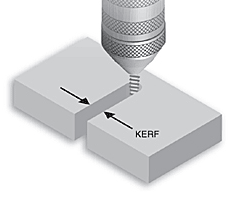
Different boards require different cutting methods, have different requirements, and use different equipment.
Furthermore, the cuts produced by cutting materials of different thicknesses also vary.
For example, a 10mm board generally has the following characteristics when cut:
(1) Cutting with a metal laser cutting machine produces a cutting accuracy of ±0.025mm and a cutting width of 0.2~1mm.
(2) Cutting with a plasma cutting machine produces a cutting accuracy of ±0.3mm and a cutting width of 0.5~1.2mm.
(3) Manual acetylene cutting produces a cutting accuracy of ±1mm and a cutting width of 1.0~1.5mm.
For materials with a thickness of less than 3.0mm, the cuts are generally between 0.3 ~ 0.5mm.
The thicker the material, the greater the cutting edge, which is also related to the cutting nozzle and the method used.
Factors Affecting Cutting Edge
Laser cutting machines have been in development for many years and have gradually become the main processing equipment for metal processing.
However, there are always some problems with cutting, such as producing a cut that is too wide.
So, what are the factors that affect the cutting width of a laser cutting machine?
There are four main factors:
1. Laser beam quality
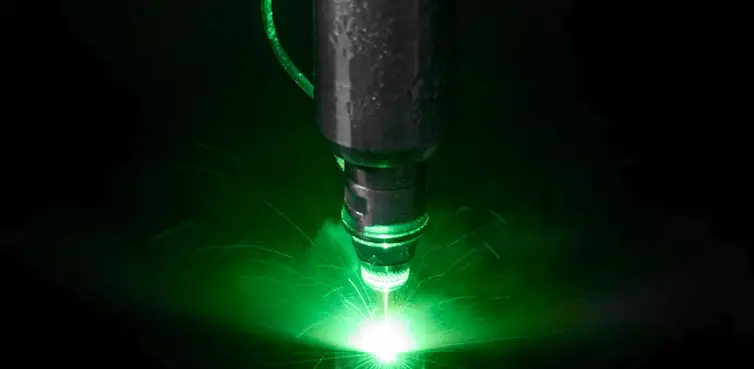
The laser beam generated by a laser is not emitted vertically, but at a scattering angle.
Therefore, when using a laser cutting machine to cut a part, a certain taper will be formed. Therefore, the quality of the laser beam is also critical for cutting.
Generally, the focus should not be adjusted arbitrarily after adjustment. It should only be adjusted when there are visible problems with the cutting effect.
two. Different cutting materials
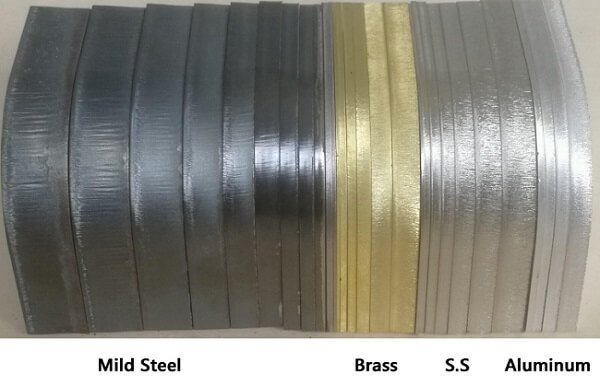
The actual cutting effect varies depending on the material being cut.
In laser cutting, a smaller spot of the laser beam produces a better cutting effect.
In addition to the quality of the laser beam affecting the spot, the material of the part also affects the size of the spot.
For example, copper is highly reflective, which makes it difficult for light spots to form. Therefore, the requirements of a copper laser cutting machine are higher compared to common metals.
3. Material thickness
Under the same material and mechanical cutting conditions, the thicker the material, the more likely it is to have burrs and irregularities in the cross section.
To obtain exactly the same section of sheet material, the laser power needs to be increased.
4. Cutting speed
The reason why laser cutting machine is widely accepted is because of its fast cutting speed.
When other conditions remain constant, the cutting speed of a laser cutting machine must be adjusted accordingly to obtain the best cutting effect.
If the speed is too slow, the roughness of the cut may be too large. If the speed is too fast, the roughness of the cut may be reduced.
However, if the speed is too fast, it may not be able to penetrate the material, so it is essential to control the speed and not blindly pursue high-speed cutting.
Relationship between cutting speed and cutting width
When the laser power and auxiliary gas pressure are constant, the laser cutting speed maintains a nonlinear inverse relationship with the cutting width.
As the cutting speed increases, the cutting width decreases. As the cutting speed decreases, the cutting width increases.
There is a parabolic relationship between the cutting speed and the surface roughness of the cutting section.
As the cutting speed decreases, the surface roughness of the section increases, and as the cutting speed increases, the surface roughness improves.
When the ideal cutting speed is reached, the surface roughness of the cutting section is minimized.
If the cutting speed increases to a certain value, the board cannot be cut.
Relationship between focus position and crop width
The most significant factor that affects the quality and processing capacity of a laser cutting machine is the focus position, and its specific relationship with processing is as follows.
The focus position is defined as the position after the laser beam is focused relative to the surface of the processed material.
The focus position affects almost all processing parameters such as width, slope, cutting surface roughness, slag adhesion state and cutting speed.
This is because changing the focus position causes a change in the beam diameter at the surface of the processed material and the angle of incidence at the processing material.
Consequently, it affects the formation state of the cut and the multiple reflections of the beam in the cut, which affects the flow state of the auxiliary gas and molten metal in the cut.
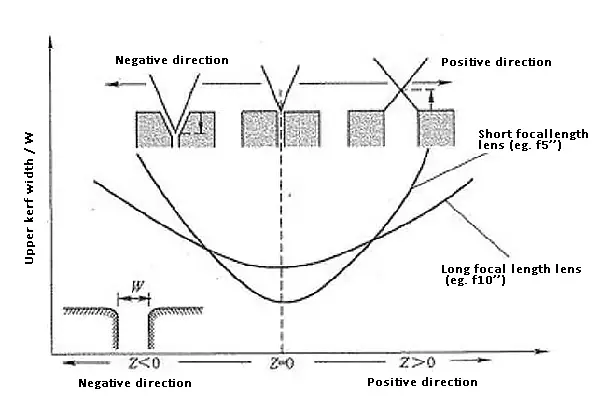
The figure shows the relationship between the focus position Z of a laser cutting machine and the cutting width W of the surface of the processed material.
The focus state on the surface of the processed material is set to Z = 0 “zero”, the focus position is represented by “+” when moving up, “-” when moving down, and the amount of movement is in mm.
When the focus is at focus position Z = 0, the top cut width W is the minimum.
Whether the focusing position moves up or down, the top crop width W becomes wider.
This tendency is the same when processing lenses with different focal lengths.
The smaller the beam diameter at the focus position and the smaller the focal depth of the lens, the greater the upper cutoff width will vary with changing focus position.
| Focus position | Characteristics | Application |
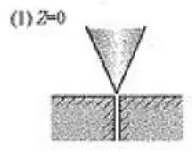
|
The cut is the narrowest and can be processed with high precision | Processing that requires slope reduction; Processing with high surface roughness requirements; High speed cutting; Reduce processing of the heat-affected zone; Micromachining |
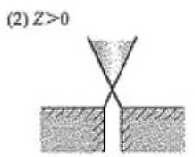
|
Flaring below the cut can improve gas flow and melt fluidity | CW and high-frequency pulse processing of thick plates; Acrylic plate processing; Tool processing; Ceramic tile processing |
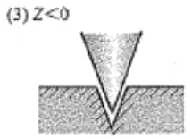
|
Flaring above the cut can improve gas flow and melt fluidity | Pneumatic aluminum cutting; Nitrogen cutting of aluminum; Pneumatic cutting of stainless steel; Nitrogen cutting of stainless steel; Air cutting of galvanized steel sheet |
The above figure shows the best focusing position of the metal laser cutting machine when processing various processing materials.
(1) The minimum beam diameter Z = 0 can be obtained from the surface of the material.
At this point, the maximum energy density can be obtained on the surface of the processed material, and the melting range is relatively narrow, which determines the processing characteristics.
(2) The focus position is on the “+” side (Z > 0).
At this point, the irradiation range of the laser beam on the surface of the processed material becomes wider, and the beam in the cut has a diffusion angle, which increases the cutting width.
(3) The focus position is on the “-” side (Z <0).
At this point, the range of the laser beam radiated on the surface of the processed material becomes wider.
The closer the focus position is to the plate thickness direction, the greater the melting capacity, and then a reverse tilt occurs.
Three solutions for cutting very wide cuts
Normally, during laser cutting machine processing, there are cases where a large cutting edge occurs. This situation results in low cutting accuracy, which does not meet our requirements.
What is the reason for this situation? Is there a way to resolve this?
After continuous observation and analysis, the technical engineer devised three solutions:
- We need to check whether the focal length of the fiber laser cutting machine is correct.
Adjustment of the optical fiber focal length can be manual or automatic.
Manual focus tends to be overlooked by technicians, especially after lens replacement or cleaning; therefore, the focal length must be readjusted.
- Lenses are a key factor.
Check the lens for damage or dirt, as this can cause laser scatter and beam thickening. Replacing or cleaning the lens is the only solution.
- The positioning of the laser tube is also crucial.
Check the quality of the laser point.
If there are two dots or the light spot is not round, the laser tube fulcrum may need adjustment.
This reason is often overlooked, but it still demands attention.
Large laser cutting seams are not a significant problem, but the equipment must undergo maintenance after production and processing for a certain period.
In fact, some minor irregularities may occur during use, which requires proper maintenance to ensure the long-term and efficient operation of the laser cutting machine and create maximum value for users.
Experience in ensuring laser cutting quality
The factors that affect the quality of laser cutting are very complex.
From the above content, we know that in addition to the processing material itself, many other factors determine the cutting width, including beam characteristics, laser power, cutting speed, nozzle type (opening) and nozzle height, position of the focus, type of auxiliary gas, and pressure, among others.
See too:
- How to select the power of fiber laser cutting machine?
- Laser Cutting Thickness and Speed Chart
Here are some tips to ensure cut quality when using a laser cutting machine:
- Good cutting quality (i.e. cutting focus) is very important for the cutting process. At least it will affect the cutting effect, and the burr is serious. In the worst case, it will cause severe burns to the edges and the board to explode.
- However, once the focus is aligned, it is usually not necessary to adjust it repeatedly. Generally, it needs to be adjusted when there are obvious defects in the cutting effect.
- Furthermore, the lens needs to be adjusted after maintenance.
- It also needs to be adjusted when repeatedly changing thin and thick plates.
- The necessary test cutting must be carried out before replacing the board to ensure that there are no problems in the processing process.
Note: Observe every day and maintain the lens once a week.

























































